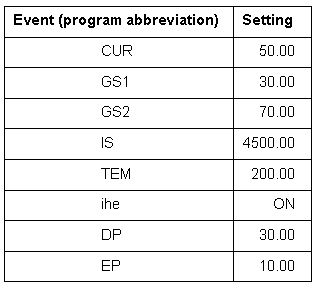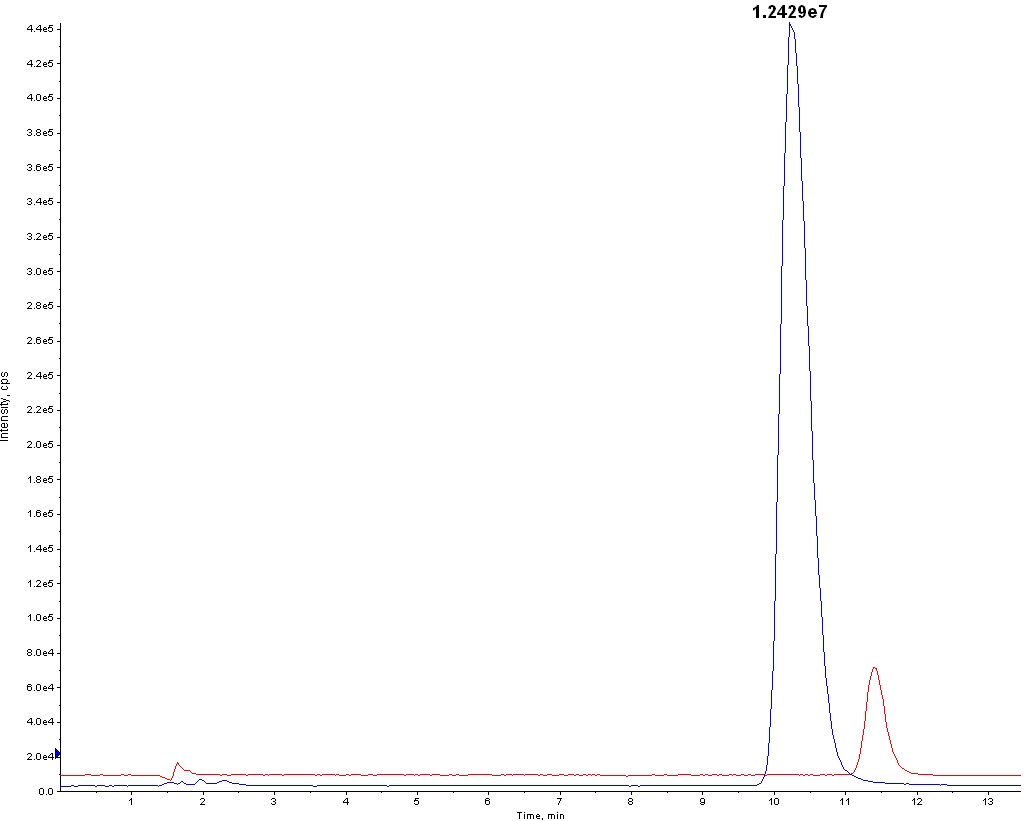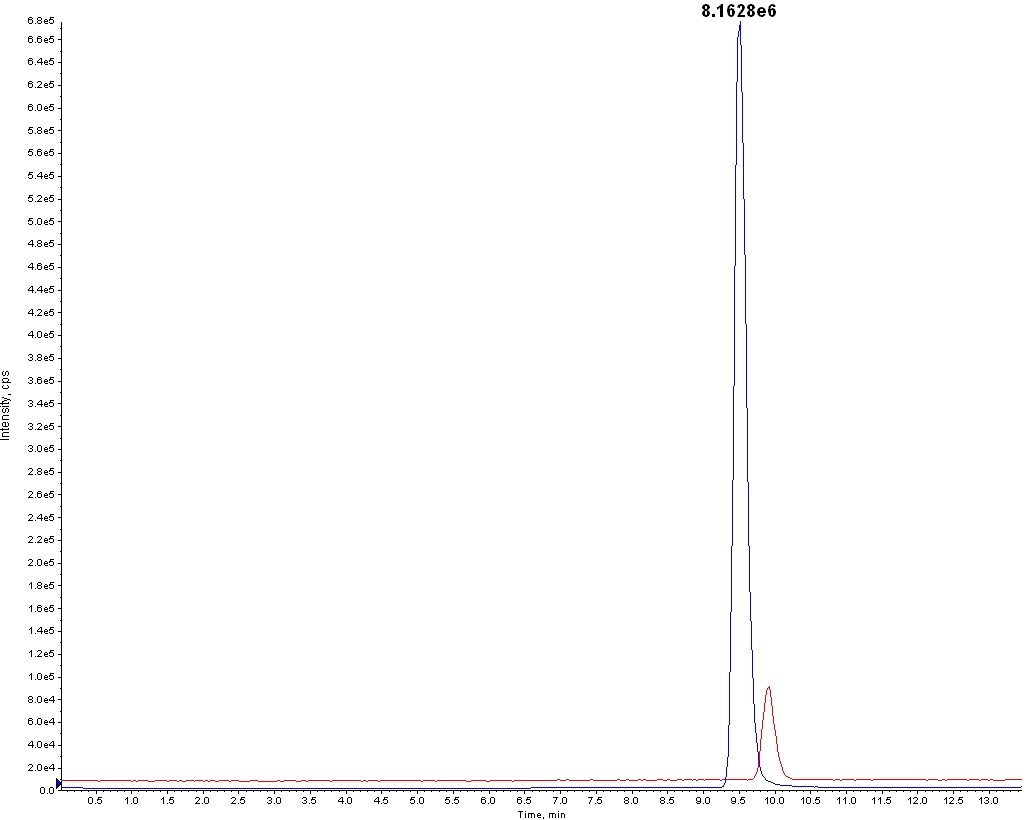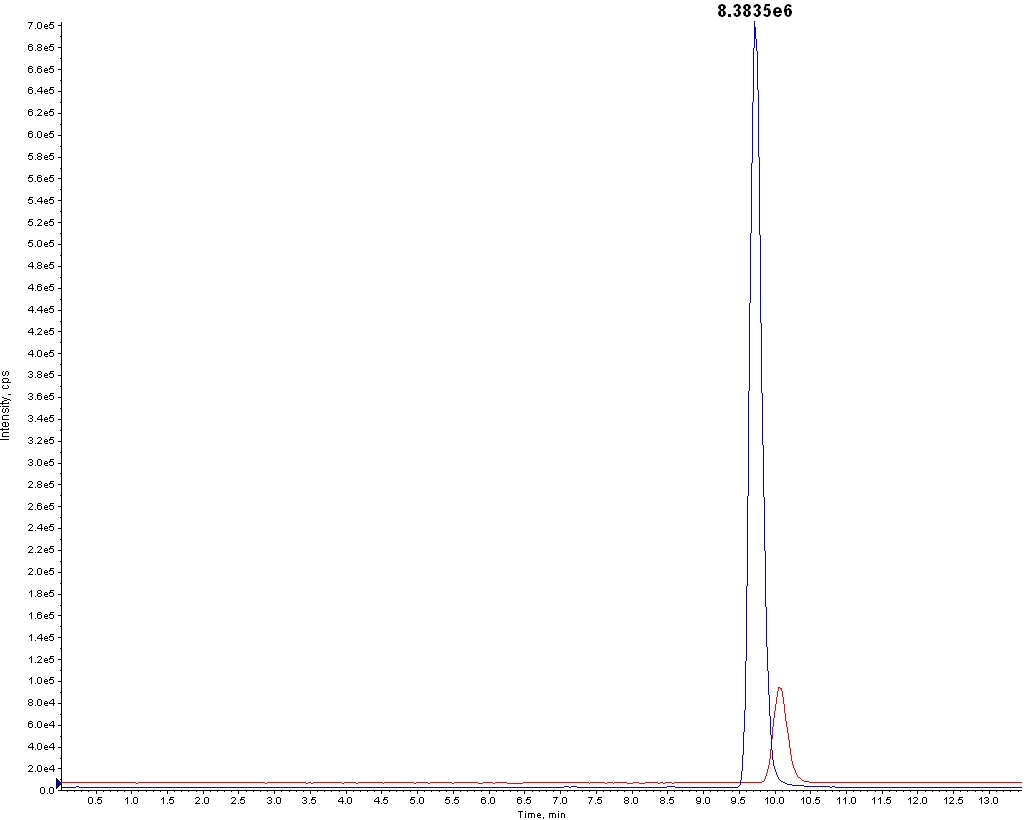[Modifikation des IFCC Referenzmessverfahrens zur Bestimmung von HbA1c mittels HPLC-ESI-MS]
Patricia Kaiser 1Theodorus Akerboom 2
László Dux 3
Hans Reinauer 1
1 Reference Measurement Laboratory, Instand e.V., Düsseldorf, Germany
2 Department of Clinical Chemistry and Laboratory Diagnostics, Heinrich-Heine- University, Düsseldorf, Germany
3 Department of Biochemistry, Albert Szent-Györgyi University Medical School, Szeged, Hungary
Zusammenfassung
Das Referenzmessverfahren zur Bestimmung von HbA1c (glykiertes Hämoglobin) mittels HPLC(Hochleistungsflüssigkeitschromatografie)-ESI(Elektrospray-Ionisation)-MS(Massenspektrometrie) wurde modifiziert. Die wesentlichen Modifikationen bestehen in der Änderung der Zusammensetzung des HPLC-Puffers, der Änderung des Gradientenelutionsprofils und der Einführung eines „post-column splitting“ Systems. Darüber hinaus erwies sich die Langzeitstabilität des HPLC-ESI-MS Systems als äußerst wichtig für die Reproduzierbarkeit der Ergebnisse.
Unter Verwendung der modifizierten HPLC Bedingungen wurden stabile Retentionszeiten, eine hohe Peaksymmetrie und eine gute Reproduzierbarkeit, auch bei verschiedenen Säulenchargen erreicht. Es wurde eine Abweichung von den Zielwerten von weniger als 0,7% und eine Unpräzision von weniger als 2% erzielt.
Schlüsselwörter
HbA1c, Referenzmessverfahren, HPLC-ESI-MS
Introduction
The original IFCC (International Federation of Clinical Chemistry and Laboratory Medicine) reference measurement procedure for the determination of HbA1c in human blood has been developed by an international group of laboratories collaborating in the “IFCC Working Group on Standardization of HbA1c” and has been published in detail [1]. The principle of measurement of the IFCC reference measurement procedure is based on the determination of the ratio of glycated and non-glycated N-terminal hexapeptides of the β-chains of haemoglobin.
Under our conditions the original IFCC reference measurement procedure showed a lack of robustness. Unstable retention times between column batches and within a measuring sequence were observed. Additionally, peak tailing was seen, resulting in a poor reproducibility of the results. Since the calibration is based on time-consuming measurements of external standards the long-term stability of the HPLC-ESI-MS system is of high importance to get reproducible results.
The aim of this study was to find analytical conditions to get a higher robustness of the measurement procedure combined with a better accuracy and precision.
Materials and methods
Chemicals
Trifluoroacetic acid (25% solution in water) and acetonitrile (LiChrosolv) were purchased from Merck, Darmstadt, Germany. For proteolysis endoproteinase Glu-C (sequencing grade, EC 3.4.21.19) was obtained from Roche Diagnostics, Penzberg, Germany. Synthetic glycated hexapeptide (1-Deoxyfructosyl-VHLTPE) was obtained from Orpegen Pharma, Heidelberg, Germany.
Water was prepared using the purification system Direct-Q™ 5 (Millipore GmbH, Eschborn, Germany). The Zorbax SB-CN column (2.1 x 150 mm, 5 µm) was obtained from Agilent Technologies Deutschland GmbH, Böblingen, Germany.
Apparatus
The HPLC system used was from Shimadzu (Duisburg, Germany) and consisted of a SCL-10A system controller, three LC-10ADvp pumps (A, B, C), a DGU-14A degasser, a SIL-10AD autoinjector, a CTU-10AS column oven, and a FCU-12A Flow Switch (rotary valve).
The mass spectrometer was an API 4000 equipped with a TurboV™ ESI source with Turboion Spray™ probe from Applied Biosystems (MDS-Sciex, Darmstadt, Germany).
Sample preparation and calculation
The samples were prepared according to the original IFCC reference measurement procedure [1].
Briefly, the method has three steps:
In the first step the whole blood sample is haemolysed. In the second step a proteolytic cleavage of haemoglobin is performed. For proteolysis the haemolysed sample is treated with endoproteinase Glu-C to cleave the polypeptide chain at the Glu-Glu positions. During the enzymatic cleavage of the β-chains of haemoglobin glycated and non-glycated β-N-terminal hexapeptides are generated. In the third step the hexapeptides are separated chromatographically and measured by LC-ESI-MS.
Quantification is performed by external calibration. For calibration six mixtures of chromatographically purified HbA1c and HbA0 (“calibrators” obtained from the IFCC Working Group on Standardization of HbA1c) are digested (together with the controls and EQAS (External Quality Assessment Schemes) samples) and analysed by LC-ESI-MS. For the calibration curve the ratios of the concentrations of HbA1c and HbA0 in the calibrators are plotted against the peak area ratios of their β-N-terminal hexapeptides. The percentage of HbA1c in the sample can be calculated from the regression curve. According to the protocol of the IFCC reference measurement procedure for HbA1c the calibrators are measured before and again after the controls and EQAS samples. The total analytical time for measurement, including calibrators, controls and EQAS samples is about 24 h. More information can be obtained at http://www.ifcchba1c.net/.
HPLC-MS measurement conditions
The modified conditions for determination of HbA1c were as follows:
Elution was performed on Zorbax SB-CN column (2.1 x 150 mm, 5 µm) using a binary gradient consisting of eluent A (pump A): 0.07% v/v trifluoroacetic acid in water and eluent B (pump B): 0.07% v/v trifluoroacetic acid in acetonitrile. The flow rate was 350 µl/min. The column temperature was 50°C. In order to avoid contamination of the ESI source a switching valve system (rotary valve A) was introduced. At position 0 of rotary valve A the eluate passed into the ESI source. At position 1 the eluate was discarded, during which the ESI source is supplied with 50% acetonitrile (eluent C), delivered by pump C (auxiliary pump), with a flow rate of 350 µl/min. The injection volume was 3 µl.
The HPLC conditions for determination of HbA1c, the settings of the API 4000 mass spectrometer and the detection masses in the Q1 multiple ion mode for the β-N-terminal hexapeptides of HbA1c and HbA0 are shown in Tables 1 [Tab. 1], 2 [Tab. 2], and 3 [Tab. 3]. (The abbreviations for settings are specific to the API 4000 software used to control the system).



The MS detection of the hexapeptides was performed at high resolution in the positive ion mode. Setting of the needle position was: horizontal axis 5 mm and vertical axis 10 mm.
Results
In long-term evaluation using the original chromatographic conditions described in the IFCC reference measurement procedure [1], [2], peak tailing (see Figure 1 [Fig. 1]), irregular peak profiles and instability of the retention time in the chromatographic separation were observed resulting in a poor robustness of the method. Additionally, a lack of reproducibility of column selectivity from batch-to-batch was detected (see Figures 1 [Fig. 1] and 2 [Fig. 2]).


The IFCC reference measurement procedure was modified in several steps. A change in the LC buffer composition, a change in the LC gradient elution profile and a post column splitting system were introduced. To prevent clogging of the ESI-probe an auxiliary pump was added, which supplies the ESI source with eluent C, when switching the ESI source out of the HPLC flow during column rinsing. The original HPLC conditions described in the IFCC reference measurement procedure and the modified conditions are demonstrated in Table 4 [Tab. 4].

One of the main modifications is the increase of the TFA (trifluoroacetic acid) concentration in both elution buffers (A and B) to 0.07%. Furthermore, a steeper gradient was introduced, followed by an isocratic phase at a higher acetonitrile concentration (10% elution buffer B).
In contrast to the original IFCC conditions the modified separation conditions give excellent peak symmetry, stable retention times and a good column batch-to-batch reproducibility (Figures 3 [Fig. 3] and 4 [Fig. 4]). The β-N-terminal hexapeptides elute within the isocratic phase of the gradient, independent of the column batches. The modified method avoids peak tailing and shifts of retention times in problematic column batches (compare Figures 1 [Fig. 1] and 3 [Fig. 3]).


Undesirable in-source fragmentation may occur by partial cleavage of the sugar residue from the glycated β-N-terminal hexapeptide leading to incorrect analytical results for the percentage HbA1c. To investigate whether under the selected conditions in-source fragmentation is generated, a high concentration of synthetic glycated hexapeptide, identical to the glycated β-N-terminal hexapeptide of HbA1c, was measured under the modified HPLC conditions. As demonstrated in Figure 5 [Fig. 5] no signal is detected on the mass trace of the non-glycated β-N-terminal hexapeptide (m/z 348.3 amu), so that in-source fragmentation can be excluded under the selected conditions.

Evaluation of the new method was performed using certified reference materials supplied by the IFCC network for HbA1c standardization.
The analytical imprecision was assessed by repeated measurements (n=39) of one haemolysate sample under the original IFCC conditions in comparison to our modified conditions (Table 5 [Tab. 5]).

Substantial improvement of precision was achieved by the HPLC modifications. The CV (coefficient of variation) was lowered by a factor of more than 2.
For accuracy control haemolysate samples with assigned target values set by the IFCC Network for HbA1c Standardization were used. A clear enhancement of accuracy was obtained by the modifications as demonstrated for the experiment in Table 6 [Tab. 6].

The mean deviation of the values from the IFCC target values measured in several campaigns was less than 0.7% with an imprecision of less than 2%.
Discussion
In the IFCC reference measurement procedure for determination of HbA1c quantification is based on calibration with external standards consisting of defined concentrations of chromatographically purified HbA0 and HbA1c. For this kind of calibration an excellent long-term stability of the HPLC-ESI-MS system is important. According to the protocol of the IFCC reference measurement procedure for determination of HbA1c [1], the results for the EQAS samples and the controls are calculated by calibration in the beginning and at the end of the measuring sequence requiring an analytical period of 24 h.
Stable peak area ratios are required for the accuracy and precision of the results, and the repeated calibration curves in one measuring sequence should be congruent. Several ESI-MS systems with different technical designs of the electrospray ionisation source were tested. The necessary long-term stability for this special application could not be accomplished with all ESI-MS systems. The API 4000 showed high system stability, resulting in reproducible calibration curves within a measuring sequence.
The precision of HbA1c measurements with HPLC-ESI-MS is strongly dependent on the stability of the retention time. The stability of the retention times and the peak form were improved by increasing the concentration of TFA in the elution buffer. The best results were obtained by adding 0.07% TFA to the eluents. Using this TFA concentration peak tailing was substantially diminished, without introducing ion suppression effects. By changing the gradient elution profile the β-N-terminal hexapeptides of HbA1c and HbA0 both eluted in the plateau phase at 10% eluent B, independent of the column batch used. The ionisation of the glycated and non-glycated β-N-terminal hexapeptides is influenced by the concentration of TFA and acetonitrile to different extent. Therefore, best reproducibility of the peak area ratios is obtained by peak elution under isocratic conditions due to stable electrospray ionisation. Narrow symmetric peaks were obtained. Since the use of the synthetic glycated hexapeptide demonstrated the absence of in-source fragmentation, it was not necessary to separate the two analytes completely.
To get reproducible results extension of the run time from 23 min to 28 min was required in order to equilibrate the cyano-column with the aqueous phase (eluent A). Column selectivity and separation characteristics were reproducible from batch-to-batch under the modified HPLC conditions.
Another important aspect is the prevention of ESI-MS system overloading. The concentration of HbA1c in samples, which are prepared according to the IFCC reference measurement procedure, is too high for direct injection into the LC-MS system, when using the API 4000. Injecting the haemolysates at volumes as low as 1 µl the linearity of the calibration curve was not satisfactory. Therefore, a post column flow splitting system was installed.
Reference measurement procedures are well defined in International Standards (ISO 15193) [3]. Their use for setting target values in External Quality Assessment Schemes (EQAS) is preferred and explained in the European Standard EN 14136:2004 [4]. In Germany the mandatory “Guideline of the Federal Medical Council for Quality Assurance of Quantitative Analyses in Laboratory Medicine” requires reference measurement procedures for setting target values for HbA1c in the national EQAS. The acceptability criteria for reference measurement procedures for imprecision and inaccuracy should be 1/3 to those of routine methods in the German Guideline [5]. Thus, the reference measurement procedure for HbA1c should have less than 2.3% imprecision and inaccuracy.
In this study the imprecision of repeated measurements was improved from more than 3% to 1.35%. More important, the target values of controls, supplied by the IFCC network were met within 2.5% with higher reliability.
The accuracy of the modified LC-ESI-MS method was ascertained in our laboratory by comparing the results with those obtained by the IFCC reference measurement procedure for HbA1c by HPLC/capillary electrophoresis [1] and by repeated successful participation in international intercomparison studies of the IFCC Network for Standardization of HbA1c.
Notes
Conflicts of interest: none declared.
References
[1] Jeppsson JO, Kobold U, Barr J, Finke A, Hoelzel W, Hoshino T, Miedema K, Mosca A, Mauri P, Paroni R, Thienpont L, Umemoto M, Weykamp C; International Federation of Clinical Chemistry and Laboratory Medicine (IFCC). Approved IFCC reference method for the measurement of HbA1c in human blood. Clin Chem Lab Med. 2002;40(1):78-89.[2] Finke A, Kobold U, Hoelzel W, Weykamp C, Miedema K, Jeppsson JO. Preparation of a candidate primary reference material for the international standardisation of HbA1c determinations. Clin Chem Lab Med. 1998;36(5):299-308.
[3] ISO 15193: 2005 In vitro diagnostic medical devices - Measurement of quantities in samples of biological origin - Presentation of reference measurement procedures.
[4] EN 14136: 2004 Use of external quality assessment schemes in the assessment of the performance of in vitro diagnostic examination procedures.
[5] Richtlinie der Bundesärztekammer zur Qualitätssicherung quantitativer laboratoriumsmedizinischer Untersuchungen [Guideline of the German Medical Association for Quality Assurance of Quantitative Analyses in Laboratory Medicine]. Dtsch Ärztebl. 2001;98(42):A2747-A2759.




